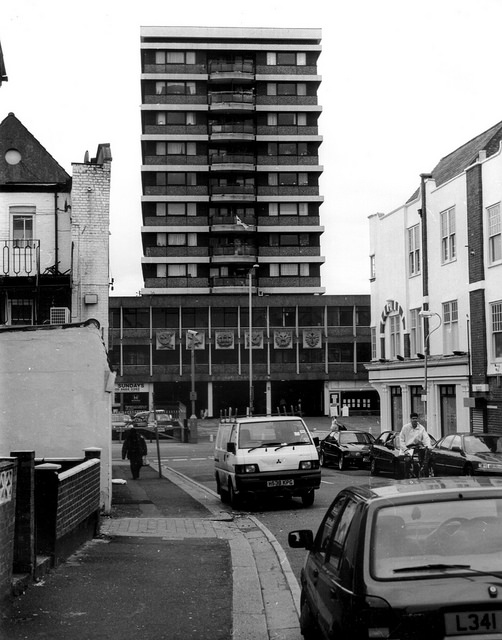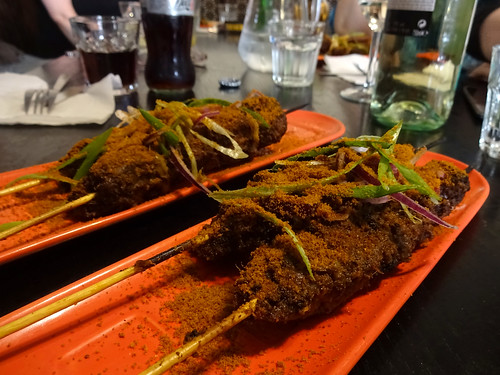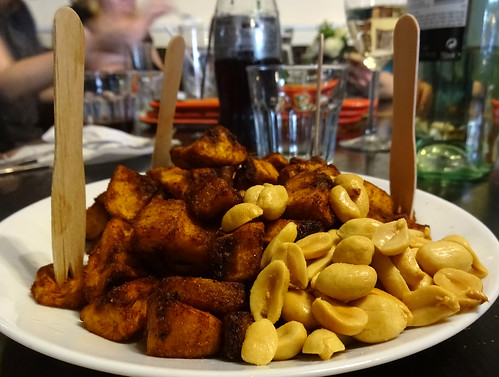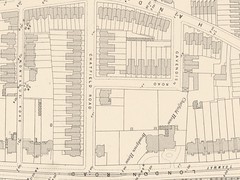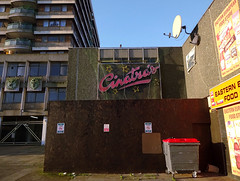Zodiac Court at 165 London Road is probably most famous for its use in the early 21st century as a filming location for the sitcom Peep Show. It’s part of a development which also includes office accommodation known as Zodiac House, a ground-floor space originally intended as a garage but now used by Timber Gardens restaurant, a block of seven small shop units, and a large, currently-unused, nightclub space.
As explained in part 1 of this mini-series, these buildings were constructed in the 1960s on the site of Broad Green House, an older property which dated back to the early 19th century. In that article, I discussed Broad Green House from the early 1800s up to the 1890s, when the grounds of the estate were broken up for housing development, and in part 2 I continued the story up to the 1960s.
Here, I describe the demolition of Broad Green House to make way for the Zodiac Court development, and happenings at Zodiac Court, Zodiac House, and the garage space until the present day. Later articles will cover the nightclub space and the block of shops.
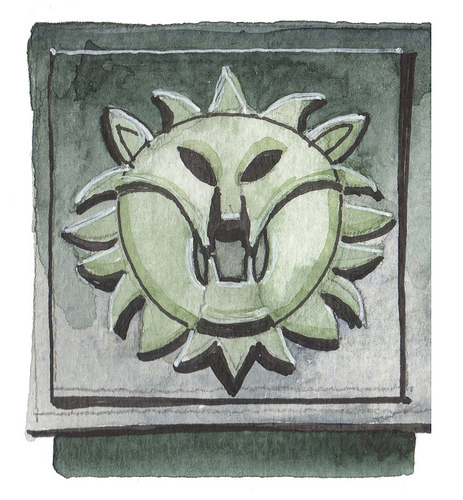
1964–1966: Demolition of Broad Green House and construction of the new development
In late 1962, the Land and House Property Corporation purchased an acre and a half of land on London Road, including Broad Green House. Although some initial discussion took place between the company’s managing director and the then-occupant of Broad Green House, Broad Green College, regarding the possibility of the latter remaining on the site, in July 1964 the college moved to new premises in South Croydon and left the site vacant and ready for redevelopment.[1]
Construction proceeded rapidly after the departure of Broad Green College, using plans drawn up by architect William H Robbins of Wigmore Street. Broad Green House was demolished and foundations for the new buildings laid by mid-November 1964, and drainage connections were complete by the end of January 1965. By June 1965 the contractors, H Fairweather & Co, were already warning that they were “behind schedule”, but the bulk of the construction was complete by the end of 1966.[2]
1960s–present: Zodiac Court
Although initial plans had been for “twelve shops with offices over; twenty-four two-bedroom flats, six one-bedroom flats, thirty garages and parking space with service road”, Zodiac Court eventually consisted of 64 flats. Rising up in a tower block at the centre of the site, these were surrounded by a ring of lower-rise offices which took the name Zodiac House, to distinguish them from the residential Zodiac Court.[3]
The flats were distributed over eight floors, with eight flats per floor. Some were designed as studio flats, and others as two-bedroom flats, and each was given a private balcony. As the flats were intended for rented accommodation rather than owner-occupied, they were supplied with district heating, a form of communal central heating in which water is heated in bulk and then circulated to individual homes.[4]
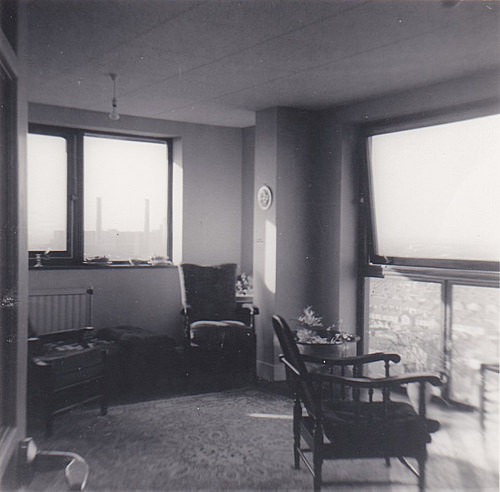
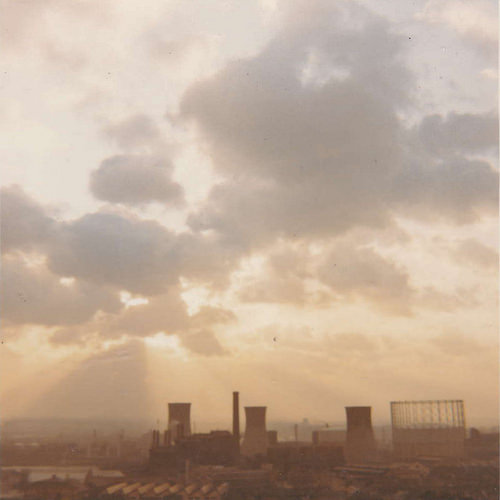
Neil Barker, who moved to Zodiac Court at the age of 9 in the late 1960s, recalls:[5]
At one time they were advertised as luxury flats — a bit of an exaggeration, but for the time they were well built and finished.
Over the years, most of the flats were bought by individuals, but some are still rented today.[6]
1960s–1970s: Zodiac House
Despite the many design possibilities offered by the zodiac concept, the only obvious reflection of this theme is found on the exterior of the office accommodation — Zodiac House. Six plaques on the London Road frontage and another six on the Chatfield Road side carry stylised representations of the twelve signs of the Western zodiac.[7]
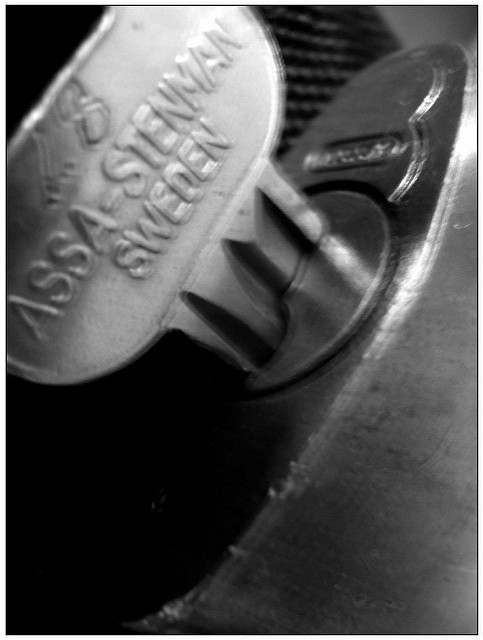
By September 1966, “30,000 Sq. Ft.” of “Offices To Let” at Zodiac House were being advertised in The Times, and the first tenants were in place by the end of the year.[8]
Several different companies used the offices over the years, including lock manufacturers Assa-Stenman; engineering firms Drake & Gorham and Drake & Scull; the intriguing-sounding yet somewhat mysterious Plastic Processing Machinery of Italy; and insurance companies Abbey Life, the National Motor & Accident Insurance Union, Malvern Insurance, and Minster Insurance.[9]
John Croudy, who worked in the computer room (“machine room”) at Minster Insurance from 1979 to 1988, shared some memories of the time:[10]
“Minster Insurance [...] did motor insurance, aviation and marine insurance, and other stuff. [...] The computers were used as follows. During the day, people would enter data. I expect this data was about people taking out insurance policies, making claims, or renewing or cancelling their policies. The machines were connected with modems to at least six other places; Manchester, Birmingham, Barnet, Sidcup, Hitchin and Darlington. These other offices would connect to the machine and feed in data.
“During the evening and overnight, all this input would be processed, the results printed, and the following day, some of the people who had input data would remotely print their results. The print-outs were sometimes actual insurance policies, schedules, renewals, cheques, etc and they no doubt eventually got sent to the customers who had insured their vehicles etc.
A Minster Insurance employee in the company’s offices at Zodiac House, c.1982. The building visible through the window in the background is on the corner of Chatfield Road and Cavendish Road (compare with Google Street View from June 2016). Photo © John Croudy, used under Creative Commons cc-by-nc-nd.“[...] the floor I worked on, the ground floor was a bit different than the other floors. It was more compact, with the machine room taking up much of the space. Towards the middle (the North side) there was a print room where they made the pre-printed stationary that we computer operators fed into the computer printers which produced the insurance documents.
Next to that, was a punch room where the ‘punch girls’ punched the cards (yes, they still used punched cards all through the 80s), a tape library and a fire safe. Next to that was Data Control where the various processing jobs were organised before being taken into the machine room for processing. The machine room was on the south side with the IT department (which we called ‘System Support’) the farthest south with their windows looking out onto Chatfield Road. [...]
“There were three sets of machines while I was there. The old ICL 1900 (blue) was a 1960s system which was still running in 1980. The ICL 2900 (orange) was designed in the early 1970s but it looked really cool and modern. The DEC VAX (also blue) was brand new but it looked cheap compared to the big iron ICL machines. [...]
The Minster Insurance machine room at Zodiac House, c.1982. Photo © John Croudy, used under Creative Commons cc-by-nc-nd.“Upstairs were two floors. My memory has faded now but I know that at least two departments were up there; the accounts department and the programming department. I’m not sure what ‘accounts’ did up there but sometimes we would have to go up to log out a terminal that they had left logged in, before we could close down the service for the night. The programmers wrote the programs that did the processing. They would write them on paper, have the girls punch them onto cards, and then submit them to us for compiling and printing. It could take a whole day to get one job back. [...]
“We used to go upstairs to those offices every now and then. There was a pool table up there which we used on night shift when the work was slow, and we had the office Christmas party up there too.”
Zodiac House was extended at least twice, first by an extra 2,950 square feet in the late 1960s, and again in the late 1970s when extra offices were built in what had until then been a covered courtyard area.[11] Nevertheless, the space seems to have fallen entirely out of use from the late 1980s onwards, and remains vacant today.[12]
1980s–1990s: Plans for a hotel
In early 1987, property company Control Securities bought the entire site, including Zodiac House, Zodiac Court, the nightclub space, and the block of shops, for £3 million (£7.7 million in 2016 prices). The company’s initial intention was “retention and upgrading” of the existing format and uses of the site, but by October 1988 it had “perceived that conversion of the office areas to an alternative hotel use might be more appropriate for the long term future of the complex”.[13]
The subsequent planning application “to convert the ground floor car showroom and the offices above to a business-class hotel, comprising 157 bedrooms, a restaurant, kitchen, four meeting rooms and two function rooms” was answered by a deluge of objections from local residents. One expressed reservations over “the ability of the applicants to maintain a hotel to any standard”, stating that “Since taking over Zodiac Court standards have dropped considerably. Levels of maintenance are negligible [...] A visit to the public areas of Zodiac Court would give anyone concern.” Others cited concerns over parking, “traffic noise and vibration by delivery vehicles, coaches etc”, and the belief that there were “already enough hotels in the area”.[14]
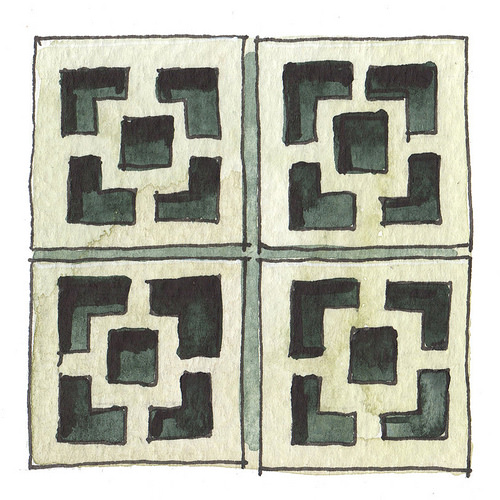
The businesses housed in the complex also expressed concerns. The proprietor of the two nightclubs in the complex, Cinatra’s and Watertown, sent a solicitor’s letter stating that “any attempts to remove him from the premises or to terminate his use of the [basement] car park will be strenuously resisted”.
These concerns were not unfounded; in the same month this letter was sent, Control Securities told Croydon Council that it was considering “the further possibility of extending [...the hotel] to include the Cinatra’s Nightclub area enabling much more extensive facilities for functions and conference use.”[15]
B Newton Motor Company, which had occupied the garage space at the base of Zodiac House for the previous four years, explained that it had spent “a considerable amount of money” improving the site from its original use as a petrol garage into “first class car showrooms selling Honda motor cars”, and that if it were forced to vacate the site it would “almost certainly cease trading as a Honda agent, with the cessation of 25 years of trading and subsequent loss of numerous local jobs.”[16]
Despite all these objections, Croydon Council’s Planning Sub-Committee noted that “It could be argued that this is a more appropriate location for a hotel than for the existing offices, which would be more appropriately located within the [Broad Green] District Centre or Croydon Town Centre.” The application was withdrawn in August 1989 in favour of a revised version, which again drew strenuous objections but was granted in October of that year.[17] For some reason, though, it was never implemented. Yet another revised application was granted in February 1993, but again nothing came of it.[18]
2017: Plans for flats
In July 2017, Croydon Council granted its approval of plans to convert Zodiac House into a total of 115 studio flats. It remains to be seen whether these plans will actually be put into practice.[19]
1960s–1990s: Godfrey Davis / Europcar
Tucked underneath the Zodiac House offices, on the right-hand side of the gates leading through to Zodiac Court, sits a small shop unit. Although this seems to have originally been intended as an actual shop, in May 1968 car hire firm Godfrey Davis Ltd was granted planning permission for illuminated advertising signs at the premises, and by late 1969 it was up and running, offering van and car rental and leasing.[20]
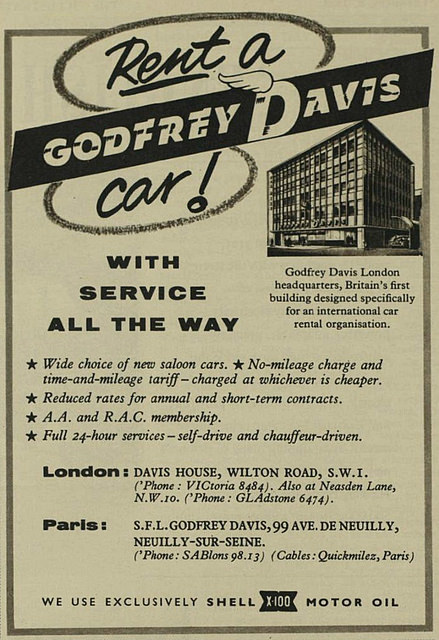
Godfrey Davis Ltd had its origins in a self-drive car hire firm established by the eponymous Godfrey Davis in 1923. It was incorporated as a private company in 1929, expanded into vehicle sales and servicing in 1938, and became a public company in 1959. Its car hire division operated as a national service; that is, one which offered customers the option of one-way rental, allowing them to return their vehicles to locations other than where they originally hired them.
By 1979 it had 195 rental outlets within the UK, including 74 at mainline railway stations and 14 at airports — the largest number in the country, and over three times as many as its next-largest competitor, Avis. Its car fleet was mainly manufactured by Ford, with the remainder consisting of Vauxhall, Talbot, and British Leyland vehicles.[21]
In April 1981, the car hire division of Godfrey Davis Ltd was purchased by Europcar, a French state-owned company that had been expanding internationally via a series of similar takeovers and other agreements since the early 1970s. It continued to operate in the small Zodiac Court shop unit under its new name of Godfrey Davis Europcar until the early 1990s, when it dropped the “Godfrey Davis” part of its name and moved to number 177, the middle of the seven shops in the block to the north of the site.[22]
The unit generally remained out of use following the departure of Godfrey Davis Europcar. It was a florists for a short while, and was later used by the site caretaker, but at the time of writing is vacant.[23]
1970s–1980s: Broad Green Service Station
In contrast to the small size of the unit discussed above, the ground-floor space on the left-hand side of the Zodiac Court gates is much more substantial, being originally intended as a car showroom and petrol filling station.
It’s not clear whether the developers had a specific occupant for this in mind, nor whether they managed to find one particularly swiftly after completion of the complex. However, by 1973, the space was occupied by the Broad Green Service Station, offering car sales, repairs, and enhancements including Ziebart rust protection. This remained until around 1983.[24]
1980s–2000s: B Newton Motor Company / Newton Honda
Next to arrive in the garage space was B Newton Motor Company, a family-run business founded in the mid-1960s at 247 Selhurst Road. It first expanded to West Croydon in the late 1970s, with a car spares shop at 212 London Road and an MOT centre at 156 Handcroft Road. Around 1983 it closed the shop at number 212 and took possession of the garage space and forecourt at Zodiac House.
B Newton remained at both Handcroft Road and Zodiac House until the early years of the 21st century, but departed both premises by the end of 2008. It’s still in business today, though, operating from 409 Brighton Road under the name of Newton Honda.[25]
2000s–2010s: Magic Fruit & Vegetable Market and Magic Carwash
The garage space remained vacant for several years after the departure of Newton Honda. At some point, the space was used by a wholesale and retail greengrocers called Magic Fruit & Vegetable Market, later replaced by a car wash called Magic Carwash & Valeting Services, but it then fell vacant again.[26]
2015–present: Timber Gardens
It might seem an unusual decision to open a greengrocers in a vacant car showroom, but the present occupant of the space is an even more unexpected one. Timber Gardens restaurant opened in February 2015, with a menu focusing on Ghanaian food but also including Chinese and Caribbean dishes.[27]
Echoes of its past as a car showroom can still be seen inside the restaurant: the lack of natural light, the expansive open space stretching back from a wide frontage, and the unusual sliding doors at the entrance. Even the private dining rooms at the back look like they might once have been the managers’ offices. Nevertheless, it’s a perfectly comfortable space for anything from dinner with friends to a night of dancing to live music.[28]
Thanks to: bob walker; Bushra Ahmed; Colin Walker; Helen Buckland; John Croudy; Lis Watkins; Mark Tandy; Martin Tapsell; Neil Barker; the Planning Technical Support Team at Croydon Council; the staff, volunteers, and patrons at the Museum of Croydon; and my beta-readers Kat and Selki. London phone books consulted via Ancestry.co.uk. Monetary conversions performed using the Bank of England inflation calculator (prices < £100 given to the nearest penny, prices from £100 to < £100,000 to the nearest pound, prices from £100,000 to < £1 million to the nearest £1,000, prices from £1 million to < £100 million to the nearest £100,000, prices ≥ £100 million to the nearest million).
Footnotes and references
- The land purchase is described in “Plans for Broad Green site”, Croydon Advertiser, 30 November 1962, and the discussion between the development company and Broad Green College is described in “School purchase — owners assure parents, pupils”, Croydon Times, 7 December 1962. The year of the college’s move is taken from a later prospectus and the month of the move is taken from an undated and unattributed advertorial newspaper clipping (prospectus and all three newspaper clippings found in the private schools files at the Museum of Croydon). See the previous article in this series for more information on Broad Green College, including what happened to it after leaving London Road.
The records of the planning application that allowed the demolition (ref 64/838, viewed on microfiche at Croydon Council offices) include a set of plans drawn up by “W. H. Robbins A.R.I.B.A.”, a chartered architect of 77 Wigmore Street W1. The Buildings of England: Surrey by Ian Nairn and Nikolaus Pevsner also states that Zodiac House was “by William H. Robbins” (2nd edition, p. 189, viewed online via Google Books).
The records of planning application 64/838 also include a card with information on various stages of completion; according to this, the foundations were laid and concrete poured by 10 November 1964, and the “F W Main” (foul water sewer, i.e. drainage for used water) and “S W Main” (surface water sewer, i.e. drainage for rainfall) were both in place and connected by 18 January 1965. Viewing the National Library of Scotland’s side-by-side comparison of the 1893–1895 1:1056 Ordnance Survey map with a modern map makes it clear that these foundations could not have been laid without first demolishing Broad Green House and Chatfield House.
An article on the front page of the 4 June 1965 Croydon Advertiser (“Late-night working angers residents”) reports on complaints from neighbours about being “kept awake until midnight by noise from the site” and gives the name of the guilty party as “H. Fairweather and Co. Ltd., who are constructing a ballroom, flats and shops for the Land and House Property Corporation.” A “spokesman for Fairweather’s” is quoted as saying “Our crane broke down and for the main part of Monday we were without it. We are already behind schedule and have to make the most of all the time we have. There was nothing else we could do but work late that night.” The abovementioned card with completion information also gives the name of the “Builder” as “H Fairweather & Co Ltd”.
Regarding the date of completion, the shops at least seem to have been complete by December 1966, as according to memos included in the records of planning applications for two of the units, the shopfronts of those two units were complete by 12 December and 20 December respectively (refs 66/3408/20/2097 and 66/2895/20/1787). Moreover, experienced building contractor Colin Walker tells me that, given the drainage connection and concrete dates (see above) and the type and scale of the development, it would likely have taken about a year and a half to build the structure, fit it out, and hand it over (via email, 9 May 2017).
- Quotation is taken from planning application 64/838. The Royal Mail postcode finder lists 64 flats at Zodiac Court today (accessed 11 July 2017), and Helen Buckland, who’s lived at Zodiac Court since 1979, confirms this number (via email, 12 July 2017). Regarding the numbering and naming of Zodiac Court and Zodiac House, the Chatfield Road entrance to the offices has signs for the number 163 and the name “Zodiac House” (see May 2017 photo by bob walker) while the London Road frontage has a sign reading “Zodiac Court 165” (see July 2017 photo by me).
- Neil Barker, who’s lived at Zodiac Court on and off since the late 1960s, tells me that the flats are on floors 3–10 of the tower block (via email, 11 July 2017), and it’s clear from the exterior that the layout is the same on each floor. Interior photos of the studio flats can be seen on Zoopla and on the James Chiltern website, while a brief description of a two-bedroom flat is available via the Internet Archive snapshot of a page from OnTheMarket. Information on balconies is from personal (external) observation. Information on rental intentions and district heating provided by Helen Buckland, who also tells me that the communal system is for heating only; for hot water, the flats have individual water heaters (via email, 11 and 12 July 2017).
- Via email, 11 July 2017.
- Information provided by Helen Buckland and Neil Barker (via email, 11 July 2017, in both cases). Neil told me that his parents initially rented their flat, but later bought the leasehold.
- Neil Barker tells me that aside from these plaques, he’s never seen anything else either inside or outside the building that relates to the zodiac theme (via email, 12 July 2017). John Croudy, who worked in the Minster Insurance offices in Zodiac House from 1979 to 1988, confirms that “There was no special ‘zodiac’ stuff to be seen” inside the offices (via Flickrmail, 30 April 2018).
- The advert appears on page 17 of the 26 September 1966 Times. The December 1966 Outer London: North East Surrey phone book lists Drake & Gorham Contractors Ltd and Drake & Scull Engineering Co Ltd at Zodiac House, London Road.
Many of these company names are taken from contemporary phone books. I haven’t gone through to check the full tenure of each one, but some sample citations are: Assa-Stenman AB, Locks and Hardware (January 1976 Croydon edition); Drake & Gorham Contractors Ltd and Drake & Scull Engineering Co Ltd (December 1966 North East Surrey phone book edition); Plastic Processing Machinery of Italy Ltd (September 1969 North East Surrey edition); Malvern Insurance Co Ltd (April 1968 North East Surrey edition, January 1976 Croydon edition); and Minster Insurance Co Ltd (July 1971 North East Surrey edition). Note that Assa-Stenman was a Swedish company; the “AB” stands for “Aktiebolag” and is the Swedish equivalent of “Ltd” or “PLC”. It has since been subsumed into the Assa Abloy Group, which still operates today.
Other names come from different sources: Abbey Life (advert on page 26 of the 5 July 1968 Times); the National Motor & Accident Insurance Union and National Motor & Contingency Insurance Group (1971 Croydon Classified Directory).
- Via Flickrmail, 30 April 2018. I have rearranged the order of some of John’s paragraphs, and also shortened some of the text (marked with [...]).
- An application for “erection of additional 2,950 Sq. Ft. of office accommodation at ground floor level” (ref 66/3389/20/2082) was granted on 12 December 1966, and the associated building plans (ref 67/2689/BR) were finally approved on 6 October 1967. Croydon Council’s records indicate that construction of this extension was complete by 16 May 1968. Another application, for “Formation of additional offices in covered courtyard area” (ref 77/20/1439), was granted on 11 October 1977. Plans included in this application show that the extension was to be built at the Cavendish Road side; a May 2017 photo by bob walker shows what seems to have been the result (dark grey bricks in centre).
- Helen Buckland tells me that Zodiac House has never been occupied in all the time she’s lived at Zodiac Court (via email, 11 July 2017).
- A small article on page 14 of the 28 February 1987 Times states that Control Securities “has acquired Zodiac House, Croydon, Surrey, a freehold office block with a substantial retail element, for £3 million from Friends Provident.” The “substantial retail element” must refer to the block of seven shops. A letter from the company to Croydon’s Borough Planning Officer (dated 30 December 1988, in support of planning application ref 88/3295/P) makes it clear that the “residential tower block and retail shopping plus a self-contained element known as Cinatra’s Night Club and Restaurant” were included in the sale. Quotations in this paragraph are taken from this letter.
- Information on planning objections taken from microfiche records of this planning application (ref 88/3295/P). A Croydon Council report dated 9 June 1989 states that there were 250 objections in total, though 240 of these consisted of “signed copies of a circular letter”. The records also include a copy of a letter addressed to “Dear Neighbour”, dated 28 November 1988, from B Newton Motor Company, urging people to object using their own words or “the enclosed letter” and “enclosed stamped envelope”, making it quite clear where this “circular letter” originated. B Newton was the then-occupant of the garage space at the base of Zodiac House, and would have been displaced if the hotel conversion had gone ahead. The quotations in this paragraph are taken from the introduction to the abovementioned Council report, two individual letters of objection, and the section of the Council report summarising the objections received.
- First quotation taken from a letter dated 9 December 1988 from Nutt & Oliver, Solicitors; second quotation taken from a letter dated 30 December 1988 from Control Securities, both to Croydon Council and both included in the records of planning application 88/3295/P.
- Quotations taken from a letter of objection from B Newton Motor Company, dated 28 November 1988, included in the records of planning application 88/3295/P. See later in the main article for more information on this company, including evidence on its date of arrival at the premises. The letter notes that the company’s 20-year lease (which, given the timing, must have been purchased from a previous leaseholder) came to an end in October 1987, that under the Landlord and Tenant Act such a lease “must be renewed, except in the case of a landlord’s wishing to redevelop the site”, and that “The present landlord only acquired this property in April 1987 for this purpose”. The “25 years of trading” likely refers to its other site at 247–249 Selhurst Road, which predated its expansion to London Road; see later in the main article for more information on this, and on the company itself.
- Quotation taken from Council report cited in a previous footnote (planning ref 88/3295/P). The index card for Zodiac Court is marked with a “W” (for “withdrawn”) against this entry, with a date of 16 August 1989. Records of the revised application (ref 89/0102/P) note that 432 letters of objection were received this time, “of which 426 are signed copies of another circular letter”.
- Ref 91/0405/P.
- Ref 17/02708/GPDO; details are available on the Croydon Council website. This was not a full planning application, but rather an application for the council to approve certain details of a development which does not require actual planning permission — in this case, conversion of office accommodation (use class B1a) to residential (use class C3), which is allowed as Class O permitted development as long as prior approval is obtained from the relevant local authority.
The original planning application for the site (ref 64/838) was for “Ballroom, Offices, Car Showroom and Petrol Filling Station, 64 Flats and 8 Shops with Car Parking accommodation”. Seven of the eight shops were in a separate block at the north of the site, and plans included in another application for the site (ref 68/20/792) mark this small unit as a “shop unit” numbered 167. Records of the May 1968 planning application (ref A4956) include drawings of signs reading “Godfrey Davis”, “Leasing”, “Rent-A-Van”, and “Rent-A-Car”. Another application by Godfrey Davis, for “Use of premises as car hire reception office”, was granted in June 1968, with the officer’s report stating that “This was approved as a shop unit on the overall development”, but that “As approval has already been given for the fascia signs [...] in connection with this proposed use, it will be difficult to refuse permission.”
“Godfrey Davis (Car Hire) Ltd” is listed at 167 London Road and at Station Approach, Epsom, in phone books from the September 1969 North East Surrey edition onwards. (In the April 1968 North East Surrey edition, it appears only as Godfrey Davis Car Rental at 161 Hersham Road, Walton-on-Thames, and at Station Approach, Epsom. The Walton-on-Thames address vanishes when the London Road address appears.) It continues to appear at 167 London Road up to and including the 1990 Croydon edition, though from November 1982 onwards it’s listed as Godfrey Davis Europcar Ltd. From the February 1992 Croydon edition onwards, it appears only as Europcar at 177 London Road.
- Information in this and the previous paragraph is taken from Compagnie Internationale Europcar and Godfrey Davis Limited: a report on the proposed merger of the vehicle rental activities, published by the Monopolies and Mergers Commission in January 1981 (sections 3.5, 3.11, 5.1, 5.2, 5.7, and 5.10; and tables 3.1 and 3.2). Table 3.1 states that as of 1979 Godfrey Davis had 195 outlets, 7,250 cars, and 990 commercial vehicles, while Avis had a similar number of vehicles but only 63 outlets. A footnote to table 3.1 gives the vehicle figures for the whole of the UK as 90,000–100,000 cars and about 25,000 commercial vehicles, meaning Godfrey Davis had a fleet share of 7–8% and 4% respectively. Table 3.2 states that its car fleet was 66% Ford, 14% Vauxhall, 12% Talbot, and 8% BL. As explained in chapter 5 of the report, the overall company also had a distribution division which acted as a Ford dealer and provided all of the rental division’s Ford cars.
- Information on Europcar ownership and expansion is taken from the report cited in the previous footnote (sections 4.1–4.8). As can be seen from the title of this report, Europcar’s purchase of Godfrey Davis was referred to the Monopolies and Mergers Commission; however, the report concluded that the proposed merger “may be expected not to operate against the public interest”, and hence could be allowed to proceed. An article published in The Times on 16 April 1981 (“Car rental giants take up their battle positions”, p21) states that the takeover took place “earlier this month”. See earlier footnote for phone book evidence on name change and move to number 177.
- Neil Barker told me: “For a short while it was a florist but it has been empty (or used as storage etc. by a previous caretaker) for many years.” (via email, 11 July 2017). Helen Buckland also confirmed the previous use by a caretaker (via email, 11 July 2017).
- Phone books list Broad Green Service Station, Car Sales, Repairs, at 161 London Road from the March 1973 Croydon edition to the May 1983 Caterham & Reigate edition inclusive, with the addition of “Ziebart Rustproofing” to the listing from July 1977 onwards. (Ziebart seems to still be in business today, albeit not in the UK.) D & H Carriages Ltd, Car Sales, is also listed from July 1977 to May 1983 inclusive; this may have been a subsidiary of the Broad Green Service Station.
Croydon phone books list B Newton Motor Company at 247 Selhurst Road from June 1966 to 2009–2010 inclusive. Google Street View images from July 2008 show Newton Honda at 247–249 Selhurst Road, clearly still in operation. The next set of images, from July 2012, show a sign in the window reading: “Great News / We have moved to 409 Brighton Road, South Croydon” (it had, however, been at the latter address since at least mid-2008, again according to Google Street View).
In addition to the 247 Selhurst Road listing, B Newton appears at 212 Selhurst Road from November 1978 (Bromley & Orpington edition) to 1992 inclusive; at 212 London Road from February 1981 to May 1983 (Caterham & Reigate edition) inclusive; at 156 Handcroft Road from 1982 to 2003–2004 inclusive (as “Newton Motor Group” in 1990 and 1992, and as “Honda/Newton” in 1993); at 161 London Road from April 1984 to 2009–2010 inclusive (as “Newton Motor Group” in 1990 and 1992; as “Honda/Newton” in 1993; as both “Honda/Newton” and “B Newton Motor Co” from 1995 to 2003–2004 inclusive; and as Honda Newton Motor Co Ltd from 2005–2006 to 2009–2010 inclusive); at 23 Station Road SE25 in 1995 and 1996; and at 409 Brighton Road from 2005–2006 to 2009–2010 inclusive (as “Newton Honda”).
I am a little sceptical of the listings at 161 London Road in later years, as Google Street View images from September 2008 show the premises looking quite vacant, while images from July 2009 show signs indicating that it’s to let and under offer. B Newton does seem to have remained here until around 2002 at least; the firms files at the Museum of Croydon include a flyer for B Newton Motor Co Ltd at 161 London Road, annotated “Jan 02” in biro.
212 Selhurst Road is listed as a “Sprs Div” [Spares Division], 156 Handcroft Road as a “MOT Cntr [Centre]” (and additionally “Workshop” from 1992), and 23 Station Road as a “Parts Dept”. When the 409 Brighton Road address appears, it’s listed as “Sales”, “MOT Centre & Workshop”, and “Parts Dept”. 156 Handcroft Road is still a car servicing centre today, run by the Strand Motor Company.
- Helen Buckland tells me that the garage space was empty for a long time after the car showroom departed, and then it was a greengrocers; and that for a while there was a car cleaning service there (via email, 11 July 2017). The name and nature of the greengrocers are taken from a photo of old signage at the premises, taken by me in June 2013 (reproduced here; see also wider view). The name of the car cleaning service is taken from its entry on the Companies House website; according to Google Street View images from November 2010, it also went by the somewhat snappier name of “Magic Hand Car Wash”.
- According to the Timber Gardens website (accessed 27 July 2017), the restaurant “opened its doors in [sic] 14th February 2015 with a special blessing from the Worshipful the Mayor of Croydon, Councillor Manju Shahul-Hameed and the Ghana High Commissioner (UK) HE Victor Smith.” Photos from the opening ceremony can be seen on Facebook and on Twitter. Regarding the menu, see photos I took of it in December 2015: page 1, page 2.
- Most of this is from personal observation. I haven’t been to any live music events here myself, but I have seen a few short videos on Instagram (no longer available, I think because the user is no longer active); see also flyer for their April 2017 “Easter Bash”.
